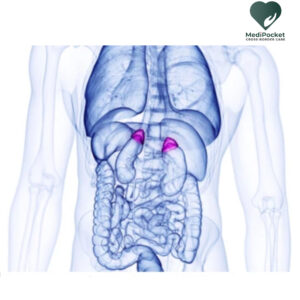Cushing syndrome is a hormonal condition that happens when the body’s tissues are repeatedly exposed to excessive quantities of cortisol. Cortisol is a stress hormone generated by the adrenal glands that is essential for the body’s stress response and metabolism. Cortisol levels that are too high might cause a variety of symptoms and health concerns.
Cushing’s syndrome can be caused by a number of reasons, including corticosteroid prescription usage, pituitary or adrenal gland tumors, or other medical disorders. The illness can afflict persons of any age, however it is most typically diagnosed in women aged 20 to 50.
Cushing’s syndrome is often diagnosed using a combination of blood testing, urine tests, imaging examinations, and other diagnostic procedures to assess cortisol levels and determine the underlying etiology of the illness. Medication to lower cortisol levels, surgery to remove tumors, or radiation therapy are all possible treatments.
Cushing’s syndrome, if left untreated, can lead to major health consequences such as high blood pressure, diabetes, osteoporosis, and an increased risk of infections. Many patients with Cushing’s syndrome can control their symptoms and improve their general health and well-being with correct diagnosis and therapy.
Symptoms of cushing syndrome
Cushing’s syndrome is a hormonal condition that causes a variety of symptoms owing to elevated cortisol levels in the body. The following are some of the most prevalent Cushing’s syndrome symptoms:
- Weight gain: Abnormal weight gain, especially around the midsection, face, and neck, is a defining characteristic of Cushing’s syndrome.
- Muscle weakness: Elevated cortisol levels can cause muscular weakness and exhaustion, making it harder to accomplish daily activities.
- High blood pressure: Cushing’s syndrome can result in hypertension or high blood pressure, which increases the risk of heart disease and stroke.
- Skin changes: Individuals with Cushing’s syndrome may have skin abnormalities such as thinning, bruising, or stretch marks for no apparent reason.
- Mood swings: Elevated cortisol levels might cause melancholy, anxiety, or irritation.
- Menstrual irregularities: Cushing’s syndrome can induce menstrual abnormalities in women, such as heavy periods, irregular periods, or period cessation.
- Increased thirst and urine: Elevated cortisol levels can produce an increase in thirst and urine, which can lead to dehydration and electrolyte abnormalities.
Cushing’s syndrome can also cause headaches, reduced libido, and compromised immunological function, which makes you more susceptible to infections.
Causes
The following are some of the most prevalent causes of Cushing’s syndrome:
Pituitary gland tumour: A pituitary gland tumor can cause the gland to create excessive quantities of adrenocorticotropic hormone (ACTH), which encourages the adrenal glands to produce more cortisol.
Adrenal gland tumour: A benign or malignant tumor in the adrenal gland can cause it to generate excessive cortisol, resulting in Cushing’s syndrome.
Corticosteroid overuse: Extended usage of corticosteroid drugs, such as prednisone, can result in Cushing’s syndrome. These drugs are often used to treat inflammatory illnesses such as arthritis, asthma, and skin ailments.
Ectopic ACTH tumour: A tumor outside the pituitary or adrenal glands can create ACTH, which encourages the adrenal glands to produce more cortisol.
Hereditary factors: Cushing’s syndrome can be induced by an inherited genetic tendency to generate cortisol-producing tumors in some situations.
To establish the best treatment strategy, the underlying cause of Cushing’s syndrome must be identified.
Diagnosing cushing syndrome
Cushing syndrome is often diagnosed by a battery of tests and exams that establish the presence of excess cortisol in the body. Below are some typical diagnostic tests and procedures:
The 24-hour urine cortisol: the test examines the quantity of cortisol in the urine over the course of a 24-hour period. It can assist in determining whether the body has an excess of cortisol.
Late-night salivary cortisol test: This test determines the quantity of cortisol in the saliva at night, when cortisol levels should be lowest. High levels can indicate Cushing syndrome.
Low-dose dexamethasone suppression test: In this test, a low dosage of the drug dexamethasone is administered, which should ordinarily inhibit cortisol production. Cortisol levels stay constant in persons with Cushing syndrome.
High-dose dexamethasone suppression test: In this test, a high dosage of dexamethasone is administered to examine if it suppresses cortisol levels in persons with Cushing syndrome.
Corticotropin-releasing hormone (CRH) stimulation test: This test includes giving CRH, which stimulates the pituitary gland to produce adrenocorticotropic hormone (ACTH). If cortisol levels remain high following this test, it indicates Cushing syndrome.
Imaging studies: studies such as CT scans or MRI, may be used to look for tumors or other abnormalities in the pituitary or adrenal glands.
It is crucial to note that the diagnosis of Cushing syndrome can be complicated, and healthcare practitioners may need to perform many tests and exams to correctly identify the illness.
Treatment
Cushing’s syndrome therapy is mostly determined by the underlying etiology. If the problem is caused by a tumor or other abnormal growth, surgery to remove it may be necessary. Radiation treatment may be recommended in specific instances.
Surgery
If surgery is not a possibility or is ineffective, medicines to lower cortisol production or inhibit cortisol’s effects on the body may be recommended. Ketoconazole, metyrapone, and mitotane are examples of such drugs. Medication may also be administered to treat particular Cushing’s syndrome symptoms such as high blood pressure, diabetes, or osteoporosis.
Lifestyle
Lifestyle adjustments may also be advised, such as a nutritious diet, frequent exercise, and stress management skills. Counseling or therapy may be helpful in certain circumstances to assist manage the condition.
Chemotherapy
If the tumor has developed and spread to other regions of the body, chemotherapy is required. In this instance, it is critical to keep track of the tumor’s growth and location.
Medication
Medication is given to lower cortisol levels. It is also necessary to keep an eye out for medicines that might trigger cushing syndrome.
Radiation therapy
Surgery may not be viable in some circumstances, thus radiation therapy is the only option. Although cortisol levels might take years to recover to normal, the radiation phase could last up to six weeks.
Difference between cushing syndrome and cushing disease
Cushing’s syndrome and Cushing’s disease are two diseases that alter the body’s production of cortisol, a hormone produced by the adrenal glands.
Cushing’s syndrome is a collection of symptoms that arise when the body is repeatedly exposed to excessive levels of cortisol, regardless of the reason. Cortisol excess can be induced by some drugs, such as corticosteroids, or by tumors on the adrenal gland or elsewhere in the body.
Cushing’s disease, on the other hand, is a kind of Cushing’s syndrome caused by a non-cancerous tumor in the pituitary gland that over-stimulates the adrenal glands, causing them to release too much cortisol. Cushing’s illness accounts for over 70% of all Cushing’s syndrome patients.
While these disorders have symptoms such as weight gain, high blood pressure, and muscular weakness, their origins and therapies differ. A correct diagnosis is required to discover the underlying cause and the best treatment option.
The following article summarizes all of the accessible information on cushing syndrome. This illness is uncommon, with less than 1 million instances reported per year. Those aged 25 to 50 are the most affected, and, strangely, women are the most vulnerable to the condition.
A message from the MediPocket world
Suffering from any condition is not pleasant, and when a person does not receive the necessary and adequate treatment, they are forced to live with the disease for the rest of their life. That is why, when it comes to health, it is critical to always select the best hospitals and specialists. It is true that the United States healthcare system is the greatest in the world, with modern technology and well-trained doctors.
That is why, with the goal of delivering long-term treatment to Indian patients, MediPocket World is virtually bringing US board-certified doctors to the people of India. This cross-border care service is the best at linking US doctors with Indian patients for second opinions, treatment in the United States, and clinical trials. Register today to begin your premium healthcare treatment journey.















